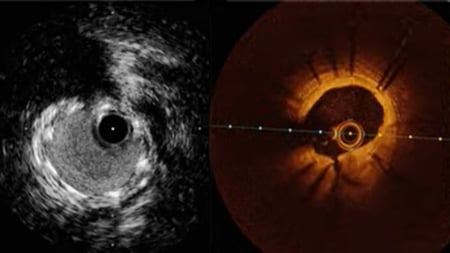Fractional flow reserve or optical coherence tomography to guide management of angiographically intermediate coronary stenosis: a single-center trial
Selected in JACC: Cardiovascular Interventions by D. Milasinovic
This study aimed at comparing the effects of fractional flow reserve- vs. optical coherence tomography-guided treatment of angiographically intermediate coronary stenosis.
References
Authors
Burzotta F, Leone AM, Aurigemma C, Zambrano A, Zimbardo G, Arioti M, Vergallo R, De Maria GL, Cerracchio E, Romagnoli E, Trani C, Crea F
Reference
JACC Cardiovasc Interv. 2020 Jan 13;13(1):49-58
Published
January 2020
Link
Read the abstractReviewer
My Comment
Why this study – the rationale/objective?
This study aimed at comparing the effects of fractional flow reserve (FFR)- vs. optical coherence tomography (OCT)-guided treatment of angiographically intermediate coronary stenosis.
How was it executed – the methodology?
- 350 patients (with 446 lesions) were randomized to FFR (n=176) or OCT (n=175) guidance.
- PCI was considered to be mandated if FFR was ≤ 0.80 or if OCT showed area stenosis (AS) ≥75%, AS between 50% and 75% and MLA <2.5 mm2, or AS between 50% and 75% and plaque rupture.
- The primary endpoint was a combination of MACE (death, non-fatal myocardial infarction (MI), target vessel revascularization (TVR)) and significant angina (Seattle Angina Questionnaire (SAQ) score <90) at 13 months.
What is the main result?
- FFR-based decision-making led to more patients being deferred to initial medical treatment (67.7% vs. 41.1% with OCT, p<0.001).
- The combined primary endpoint of MACE or severe angina was lower in patients with OCT vs. FFR guidance (8.0% vs. 14.8%, p=0.048). Of note, a nonsignificant reduction in all components of the primary endpoint were noted.
- A tendency towards less non-fatal MI was documented in the OCT arm (0.6% vs. 2.8% in the FFR arm, p=0.098).
Critical reading and relevance for clinical practice
Despite the inherent limitations of a relatively small (n=350), single-center randomized study, the FORZA trial may highlight drawbacks of a strategy that would limit intracoronary guidance to either physiology or imaging only.
In summary, FFR-based guidance was associated with lower rates of PCI, kidney injury and overall costs up to 13 months, whereas OCT-based strategy appeared to reduce MACE and angina.
To better understand obtained results, 2 important distinctions seem to be relevant. First, the indication for stenting and the subsequent post-PCI optimization may need to be analyzed separately, due to distinctly different information gained from physiology and imaging, e.g. pressure gradient across a lesion vs. plaque burden, and their respective relevance for evaluating the significance of a lesion or optimizing the post-stenting result.
Secondly, a non-negligible proportion of patients (≈20%) presented with an ACS, and FFR vs. OCT were compared in their effects to treat the nonculprit lesions. However, the recently presented data from ISCHEMIA (revascularization vs. optimal medical therapy in chronic coronary syndrome) and COMPLETE (nonculprit PCI vs. conservative management in patients with ACS and multivessel disease) trials, may indicate that revascularization could have a fundamentally different outcomes depending on the clinical presentation of coronary artery disease (chronic vs. acute).
Given the described multitude of issues pertaining to both an indication for and the optimization of coronary stenting, optimal intracoronary guidance may need to rely on the synergy, rather than mutual exclusivity, of physiology and imaging.






No comments yet!